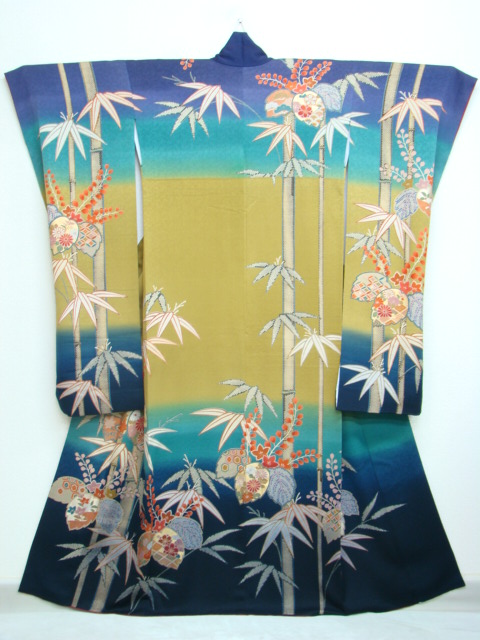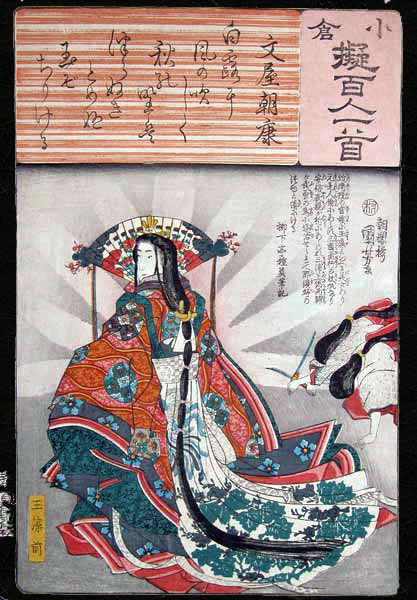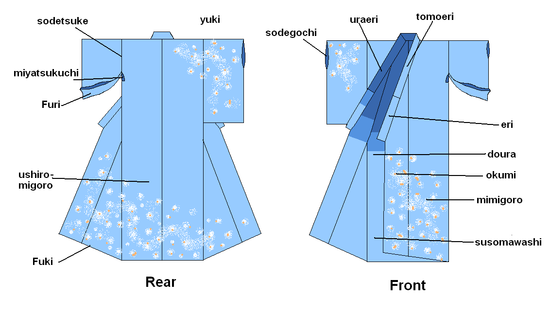Kimono
History

The Kimono was developed in Japan starting in the early 10th Century, when the Ancient Chinese styles were supplanted by the now common kimono style. This was derived from native work garments which better suited the climate, lifestyles and aesthetics of the Japanese, This was the late Heian or Fugiwara, period (897-1185). The earliest form of the kimono is the Kosode (small sleeve garment). Originally, it was a generally worn, as a plain undergarment. The farmers, crafters & merchant class continued to wear their simple two-piece garments: the Happi, a knee length top tied at the waist and loose trousers just below the knee. This was common to both sexes. Women could also wear a mid-calf, wrap-around, pleated skirt, the Mo.
In cold weather, the longer kosode would be worn. They were often padded and/or quilted for extra warmth. Through changes in decoration and sleeves, the kosode became an outer garment of the samurai class the Hitatare. (1200's forward)
During the Heian period, the men of the nobility and imperial household retained some of the ceremonial styles of China, wearing the kosode as an undergarment- Kariginu. The women embraced the kimono of the large, open sleeves, the Osede. This was the era of the 12-layer kimono, (Juni-hito) worn at court. They were unlined, with wide sleeves. Care was taken that the layers blended, matched & contrasted in an aesthetically pleasing manner. The layers were visible at the neck, sleeves and the lower skirts. Up to 20 layers could be worn. Underneath it all was a kosode and Hakama, long pleated pants. The layers were tied with sashes.
The transition from the Heian period to the Kamakura period (1185- 1333), was the change from imperial control to the shogunate and samurai. This changed the style of clothing to a simpler, more practical form, befitting the warrior class. The classic crossover front of the kimono replaced the high-collared tabard of the Heian. The men's Hitatare retained the large open sleeves that could be closed with drawstrings, but were now attached all around, instead of only under the arms. Hakama completed the outfit. A similar style for under armor and certain ceremonial activities had smaller, narrower sleeves and short trousers, or hakama wore with leggings.(Yoroi hitatare)
The lady's garments became very simple. The basic kosode sleeve had a small opening and less fabric hanging down. This was worn with hakama, the hem varying from just to the floor to dragging, depending on the occasion.
1338-1568 was the Muromachi period. This is when the tea ceremony and Noh drama were developed, along with other flowerings of artist expression. The samurai austere warrior's code had them distance themselves from the clothing of the court by wearing subdued fabrics. The men's robes were very similar to the hitatare, but were made of linen, not silk, with cords of leather, not braided silk. This was the Daimon. This garment often had the family crest (kamon) in 5 places on the kimono- 2 at the shoulders in front, 2 on the sleeves and 1 at the neck, in the back. There was no other decoration, only the fine woven patterns of the fabric.
The lady's kosode was the standard for all women, but for formal activities, an over kimono (Uchikake) was worn with the kosode under the hakama. The uchikake had longer sleeves with a small sleeve opening. In summer, the uchikake was allowed to drape over the ties of the hakama and trail behind. This could also be worn with extra-long hakama (Koshi-maki style).
During the Momoyama period (1573- 1603), warriors and land owners assumed positions of authority. This caused a change of attitude toward fashion. What ever was new and novel was highly valued. The women of the daimyo families wore richer and more elaborately decorated kimono. The ceremonial kosode and uchikaki, with a sash obi, became the standard.
After 1603, the Tokugawa shogunate was in control. The capital was at Edo, now called Tokyo. The island was closed to outsiders, except for a few Dutch and Chinese merchants at the port of Nagasaki. In men's fashion, they added the wing-shaped Kamishimo to the kimono and hakama for ceremonial attire. A formal occasion would require long, dragging hakama.
The women's styles also continued to evolve as the sleeves became much longer. Fashion was influenced by the Kabuki actors and courtesans. A style of obi was a long, braided silk cord with tasseled ends. This was wrapped around the waist and tied in back, so as to not detract from the elaborate, colorful kimono.
Later in the Edo period (1680- 1700's), the sleeves were at their longest- the Furisode style. The long sleeves were often used for flirting, so this style was worn by unmarried women and of course, courtesans and geisha. With the furisode was worn a much wider, stiff obi, tied in an elaborate bow in the back. This was the Darari-musubi. The samurai ladies would also still wear the plainer styles encouraged by the samurai code.
The obi itself became a design element, wider and heavier than before. During the middle of the Edo period, the obi developed its' now traditional size of 3.6m in length by 26.8cm. width. During this time, obi were often tied in front or back, with different tying styles coming from Kabuki actors. Men's obi were in two styles-- Kaku obi, which is stiff and the Heko obi, which is soft.
Traditional fabrics for kimono are silk, linen, cotton and wool. Patterns are produced by many methods: weaving (hand or machine), hand-painted, stencil & tie- dyeing, embroidery or combinations of techniques. All are period methods. Common dye colors were yellow, brown, black, blues, red and green. In period, white was reserved for undergarments and burial clothing. Modern western influence has changed that tradition. The older patterns from Japan include cross, parallel cross, check, plaid, stripe, diamond, dots, dashes, and squares. Stenciled and block printed patterns often reflect nature: tortoise shell, clouds, blossoms, pine needles, mums, crane, water, mountains, bamboo, leaves, insects, birds, land & sea animals. Other designs: fans, comb, yin-yang, spiral, feather, tied ribbons, etc. Check various Japanese picture prints and other artwork for more designs. The mini- series- Shogun, has lots of info for garb of the early 1600's.
The Yukata is an unlined cotton kimono originally worn after bathing. It became a garment for casual home wear, especially during the humid summer months. The colors are usually a dark blue and white pattern. A simple sash obi is wore with this style. Another summer kimono is the Jofu, made of lightweight linen. This is worn with a light cotton kosode and an open-weave silk obi.
Japanese kimono fabrics are about 13"-15" wide, some can be 28" wide. Standard fabric of 44" can be used, but the pattern layout has to be adjusted. A kimono is traditionally hand-sewn to make it easier to clean. A simple set of running stitches is all that's needed.
How to make a Kimono
You may expect making a kimono to be relatively difficult, after all there is the obi, dasho, the haori, and a host of other things that make wearing the kimono (or haori) traditional and beautiful...but it really isn't all that difficult. Like a cloak or a vest, it's really almost all straight lines and boxes. In fact, a simple bathrobe pattern can often be adjusted simply to make a good kimono pattern. Only the sleeves would have to be altered. You will need basic sewing skills and some imagination , but you can do it if you've ever made any other article of clothing. I would definately recommend that you make a test-run out of muslin or something inexpensive first to make sure you have the measurements right.
A kimono should be worn with an obi as a belt. An Obi is simply a self-tying belt made of contrasting, accentual fabric, such as a dark blue obi on a brushed gold kimono. Just sew a big rectangle of the measurements that will go around your waist about twice and knot in back to secure it (though you could pin it instead of tying it if you liked). The obi is usually about as wide as your stomach (about 8"), just as you might imagine a medieval bar wench's leather belt. A thinner cord could go on top of the obi for further color or contrast. Maybe a black kimono, white obi, and black cord? Imagine the possibities...
A few notes on fabric: Traditional kimono were obviously made of silk, embroidered by hand and very expensive. Everyday kimono could be made of linen, cotton, or other fabrics, once they became more widely available in Japan. These days, some lovely bridal satins or rayon blends are available with or without screen printing that mimics the embroidery of old. Men usually choose more somber colors, such as brown, dark gold, or black, while women wore bright jewel tones or soft pastels. Complicated, flashy patterns are usually reserved for the young. I find that a simple pattern along the edge, like waves or small dragons, is elegant and stunning. You may incorporate metallic threads, tiny crystals, or whatever you like into your design, as long as you aren't going for the more traditional look.
The first thing you need to do is measure your body:
Measurement A: Take a measurement from the back of your neck (where that little round bone sticks out) to your ankles or to wherever you want the kimono to end. Add about 2-3 inches for hemming.
Measurement B: Measure the width of your back from the center of your side over the ribcage from one side to the other. Add about 5 inches for moderate fullness and another 2 for hemming. If you want the kimono to be skinnier or fuller, adjust this measurement accordingly.
Measurement C: Measure from the top of your shoulder (where it starts to curve onto your arm) down to about an inch past your wrist bone. Add another 2 inches for hemming. This will the length of the sleeve.
Measurement D: Have someone help you with this one. Hold your arm out and have them measure from the top of your arm down to about your waist. Add about 2 inches for hemming. This is the width of your sleeve.
Measurement E: Take measurement B and halve it. This is the width of the front pieces, but add about 5" to each side to allow for overlap and modesty. If you are particularly large-chested or worried about kneeling, etc., add a few more inches. Measurement A will tell you how long it should be. These are your front panels to which you will sew the collar (Measurement F).
Measurement F: Take measurement A and double it. Measure around your neck and add this number to the doubled A. Total this. This will become the colllar and front flap. You will want this piece about 5 inches wide (3" for the collar, 2" for hem). If you want your collar taller or shorter, you may adjust this number with impunity.
"What of the armholes" you say? Well, traditional kimonoes simply inserted the sleeve into the side seam, causing a narrow shoulder opening and relying upon the fullness of the sleeve to arrange for comfort. I recommend laying out the pieces as they would fit together and hollowing out semi-circles on front and back pieces where the arm would go from body to sleeve. This will mean you have to sew on a curve for a small distance, but will make it more comfortable to wear.

